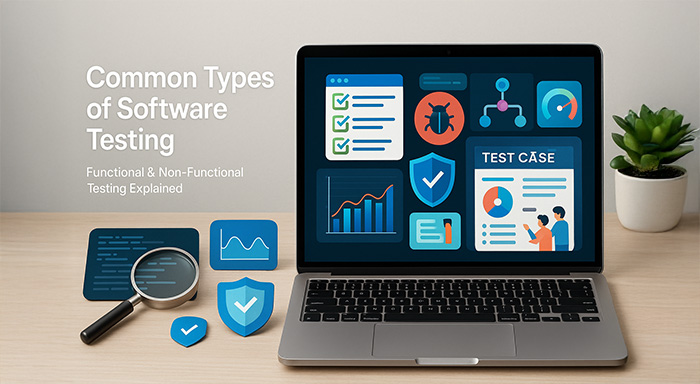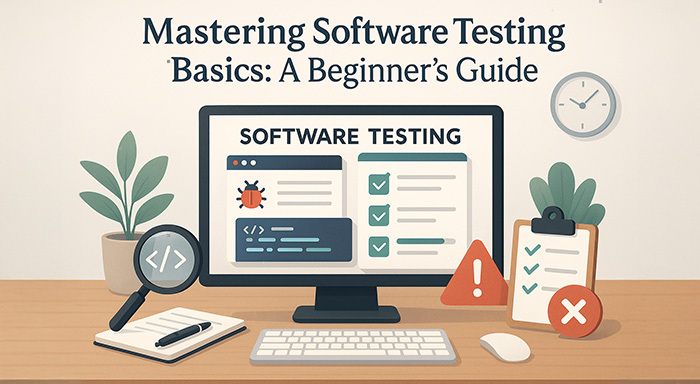In an ever-evolving digital-first era, software development has emerged as a foundation of competitive benefits and user satisfaction. Developing great software is not just about modern designs, programming languages, and
In an ever-evolving digital-first era, software development has emerged as a foundation of competitive benefits and user satisfaction. Developing great software is not just about modern designs, programming languages, and frameworks, it’s about how thoroughly it has been tested. Proper testing and validation of software is more critical than ever, as a major defect and bug can cause severe malfunction, degrade usability, and hider brand reputation. Even an expert developer can make mistakes when user expectations are not met, leading to frustration and dissatisfaction.
Software testing basics lies in verifying the quality, functionality, and reliability of a developed application based on user requirements. The process involves detecting bugs, ensuring security and optimal performance across different devices, cloud, and CI/CD pipelines in DevOps. This has become the essential solution for businesses to deliver high-quality products to stockholders with their expected results.
Whether you’re a tech enthusiast or an aspiring tester, understanding the fundamentals of software testing basics is crucial to building a reliable, secure, and user-friendly application. With this guide, you’ll navigate the core principle of software testing, including common testing types, levels of software testing lifecycle (STLC), and its importance on development environment.
What is Software Testing? Key Fundamentals
At its core, software testing is an integral part of the software development lifecycle (SDLC). This is basically a process of verifying and validating the quality of software, whether it is designed within the stockholder's expectation or not. Moreover, it lets testers know about the potential errors, overlooked requirements, and unexpected security gaps that could degrade the performance. Platforms offering technical evaluations, such as codesignal proctoring, are increasingly used to assess real-world coding quality and ensure developer performance aligns with software standards. This evaluation helps developers analyze and fix those defects, make significant changes, refactor code, and integrate the expected behavior before launching. This early detection helps businesses save remediation costs, reduce the need for post-launch fixes, improve software quality, and deliver tailored solutions.
Primarily, software testing involves:
- Verification: Confirms whether the product is built correctly, tailored to specification, user needs, and development standards with no code deployment.
- Validation: Ensuring that the software is supposed to be designed in a way that meets user requirements and business goals in the real-world scenario.
- Quality Assurance: Ensure delivery of a dependable, secure, high-quality, and user-friendly product without unexpected bugs and error risks.
Also Learn: Selenium Interview Questions: Top 30 Questions You Must Know
Why is it important? Key Benefits Explained
Skipping software testing during the development cycle can cause critical issues that can harm your system performance and damage brand reputation. Since the technological landscape evolves rapidly, having knowledge of software testing basics can be beneficial for businesses and testing enthusiasts. There are several consequences that highlight its importance:
1. Improves Quality and Performance:
A customer can be satisfied when an ideal product is delivered that aligns with their expectation of quality and performance. For achieving this kind of user satisfaction, businesses need to ensure the software is bug-free and meets all requirements before delivering it to customers. Even slight oversights can cause unexpected errors, degrade performance, damage user experience, and cause long-term reputational harm.
2. Cost Savings:
Early execution of thorough testing during development process minimise the cost of resolves bugs compared to post deployment fixes. This involves implementing risk-driven testing, cloud-based testing, and testing tools to mitigate licensing charges and ensure scalability. Therefore, it results in preventing harmful software failures, reduces downtime, and saves expensive remediation costs.
3. Enhance Security:
The highly vulnerable landscape requires businesses to provide security-focused products that protect personal information against cyberattacks. Organizations need to focus on delivering secure products to prevent data breaches, payment fraud, and severe financial loss. For example, implementing software testing basics helps financial sectors to implement secure payment gateways and robust data security for seamless user experience.
4. Greater User Experience:
A seamless, compelling user experience is essential for businesses to build trust, boost engagement, and increase conversions. Performance issues, security risks, system failures, and complex interfaces can cause user dissatisfaction with their product and give negative feedback. This is why focusing on bug-free, functional, and reliable software is crucial for users to stay happy, confident, and supported.
Common Types of Software Testing

There are numerous types of testing designed for different purposes; however, choosing wisely can make all the difference. Mainly, testing is extensively classified into functional and non-functional testing, which is then categorized into more specific types. Having theoretical and practical knowledge of these testing methods has become key for software testing basics. Here’s the detailed breakdown:
1. Functional Testing
Functional testing ensures every function of the application functions smoothly with the specified requirements and specifications. Basically, the main goal is to check whether the system behaves as it is supposed to do, verifying user interaction, input/output, and features with user expectations. Functional testing involves various kind of testing, which include:
- Unit Testing: Tests individual components of software applications to ensure every part of the software works as intended.
- Integration Testing: Here individual components or modules are combined together in a group to test the functionality of applications.
- System Testing: Execute testing on developed or integrated software to ensure compliance with user requirements and business goals.
- Regression Testing: Used to test previously executed tests to ensure fixed bugs, refactored code, or newly added features don’t affect the existing functionality of software.
- Smoke Testing: Quick testing ensures the basic, essential functionalities of software work as expected before diving into in-depth testing.
- Interface Testing: Verifying the communication between different components and precise transmission of data across different interfaces within a software application.
- Acceptance Testing: Here the product is tested to evaluate whether it performs based on user expectations at the final stage of the development lifecycle.
2. Non-Functional Testing
Non-functional tests are performed to validate that the software does things in right way, unlike functional testing which checks that whether code is doing the right things. Testers often use these testing methods to check the usability, performance, and reliability of a developed software. In software testing basics, these are the key non-functional testing methods:
- Performance Testing: Analyze performance and measure response time, loading speed, and throughput according to the ideal workload so that it meets the specified criteria.
- Security Testing: Identify weak endpoints, common vulnerabilities, and potential data threats within systems in order to safeguard personal or sensitive data against deliberate cyberattacks.
- Usability Testing: Evaluate the ease, flexibility, and user-friendliness of a system for end users, along with identifying weak points and errors that a user may address.
- Stress Testing: Checks whether the system handles heavy loads and extreme conditions by intentionally putting pressure beyond its routine operational limit.
- Load Testing: Measure performance, response time, and usability to check whether the system works under the specified criteria and expected user loads, especially in the peak traffic duration.
- Compatibility Testing: Determine the compatibility, stability, and functionality across different platforms, devices, or systems. The goal is to make system performance consistent and seamless for all users and specified environments.
Manual vs. Automation Testing: What’s the Right Choice
When exploring software testing basics, it’s crucial to understand that process can be achieved through its two main methods, manual or automation testing.
| Factors | Manual Testing | Automation Testing |
| Goal | Test cases are deployed by human testers and focus on usability, user satisfaction, and exploratory testing. | Test cases are deployed by software tools and ensure accuracy, speed, and consistency in iterative and complex testing. |
| Cost-effectiveness | Initially, it consumes minimal investment but can vary based on project’s size and complexity. | Requires high upfront costs for advanced tool set up but can be cost effective if executed for long-run. |
| Processing Time | Manual processing leads to significant delays and human errors, especially for repetitive tasks. | Automation ensures fast processing where thousands of test cases are executed in a short time. |
| Performance | Measurable performance with repetitive error risks. | Better performance and load capacity with preciseness and reliability. |
| Skill Requirement | No need for programming knowledge, basic domain knowledge is enough for manual testing. | Need to have knowledge of scripting, tool expertise, and automation frameworks. |
| Areas of Applications | Best for Ad hoc testing Usability testing, and exploratory testing in small projects. | Ideal for load testing, performance testing, and regression testing for larger projects. |
Conclusion:
Comprehending software testing basics is vital for everyone seeking to design a good software application tailored for user needs. This is not just about tech essentials, it’s about enhancing user experience, operational efficiency, and business success. However, no organization can deliver reliable software with no errors and robust functionality to customers. This often requires thorough testing, from manual to automation and load to performance testing depending on the need and scope of your project.
Software testing remains the cornerstone in the software development process for providing reliable high performing applications. Regardless of whether you’re an aspiring quality analyst or an experienced software tester. This technology not only fix bugs and improves system performance but also boosts trust, strengthens business reputation, and drives growth.
Respond to this article with emojis






